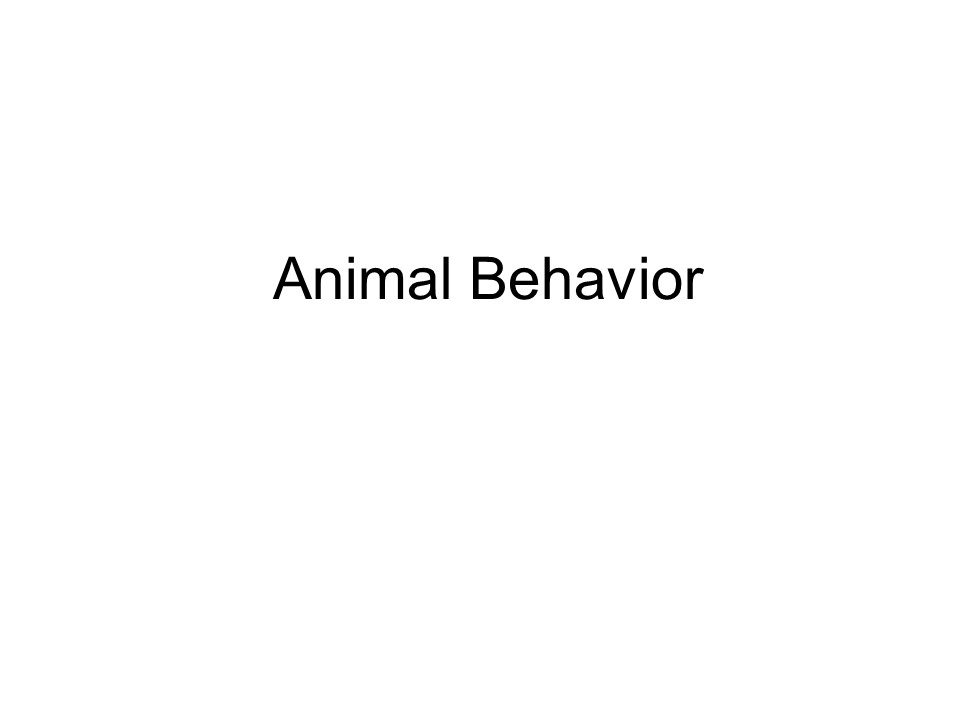Animal Behavior - PowerPoint PPT Presentation
Title:
Animal Behavior
Description:
Animal Behavior Animal Behavior Behavior: anything an animal does in response to a stimulus in its environment Ethology Study of how animals behave 4 main questions ... – PowerPoint PPT presentation
Number of Views:326
Avg rating:3.0/5.0
Title: Animal Behavior
1
Animal Behavior
2
Animal Behavior
- Behavior anything an animal does in response to
a stimulus in its environment
3
Ethology
- Study of how animals behave
- 4 main questions
- What stimulus elicits a behavior and what
physiological mechanisms mediate a response? - How does the animals experiences during
development influence the response - How does the behavior aid survival and
reproduction - What is the behaviors evolutionary basis.
4
Instincts
- Innate behavior fixed
- (inherited)
- behaviors that all the
- animals in a population
- are born with (associated
- with instinct)
5
Movement
- Kinesis change in activity due to a stimulus
- Taxis orientation towards or away from a
stimulus
6
Migration
- Migration a long distance change of locations
done at regular intervals - Usually stimulated by seasonal changes
- Use the sun, north star, or the earth magnetic
field
7
Rhythms
- Circadian rhythms daily cycles (rest, eating,
etc), usually regulated by light and dark - Circannual rhythms yearly cycles usually linked
to seasons. - Cortisol, released by the adrenal gland
8
Territoriality
- - defense of a physical space, territory
- Songs, calls, intimidation, marking territory,
- attack,
- chase
bashing-bison.
9
Fight or Flight
- The decision to fight or run is measured by risk
and reward (benefits should out weight costs)
10
Signaling
- Usually, visually, chemical, or auditory
11
Learning
- Nature vs nurture- Genetic inheritance vs
Environmental Influences
12
Imprinting
- Imprinting a life long reaction or bond to an
object or individual created at a young age - Usually a baby raised by a different species
mistakenly believes he is of that species
13
Learning
- Habituation a reduction or loss of reaction to
a stimuli (crying wolf)
14
Classical conditioning
- Classical conditioning a stimulus elicits a
response - Povlovs dog ringing a dinner bell before
dinner causes the dog to salivate without food
being present
15
- Pavlovs dogs
16
Operant Conditioning
- Operant conditioning an animal connects his
behavior with a good or bad response (trial and
error) - Rewarding dog with a treat
17
Cognition
- Cognition the ability to think, reason and
process information. - Cognition can be used to problem solve
18
Selection and Survival
- Most behaviors are ultimately formed by natural
selection for survival and reproduction
19
Mating Systems
- Promiscuous no mating bonds
- Monogamous strong bond forms one male one
female for a long period - Polygamous one sex mates with others
20
Antagonistic behavior
- Competition to gain access to a resource.
21
Altruism
- Altruism- animals reduces their individual
fitness to increase the population fitness - Insect societies- reproduction limited to only
one pair, the queen and her mate. Workers take
care of female and larvae gather food
22
Social Learning
- Social learning an individual learns by copying
the behavior of a more experienced individual. - This breeds culture.
- Increases fitness
23
Mate choice copying
- Mate choice copying females choose mates that
other females find attractive

